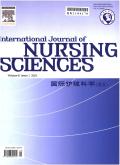癌症患者中心线相关血流感染的患病率和使用倾向评分匹配的亚组分析:意大利一项全国性多中心研究
IF 3.1
3区 医学
Q1 NURSING
引用次数: 0
摘要
目的:本研究旨在分析意大利住院成人癌症患者长期中央线相关血流感染(CLABSI)的患病率,并比较因既往CLABSI而需要长期中心静脉通路装置(LCVAD)替代的患者与从未经历过CLABSI的患者的特征。方法该研究于2021年3月至9月在意大利北部和中部的医院进行,采用多中心、观察性、横断面设计。该研究共纳入174名成年癌症患者。通过电子病例报告表格收集数据,包括人口统计学、临床、治疗相关和导管相关变量。倾向评分匹配(PSM)用于比较由于既往CLABSI而接受LCVAD替代的患者与从未经历CLABSI的患者的特征。通过多重对应分析(MCA)来探索匹配子组内的模式。结果CLABSI患病率为3%,5.2%的患者因既往CLABSI而需要LCVAD替代。应用PSM后,各组在性别、年龄、是否存在转移、合并症、BMI、接受治疗、皮质类固醇治疗、正在使用的抗生素、激素治疗、LCVAD类型、管腔和使用频率等方面成功平衡。CLABSI组血液癌发生率(44.4%)高于非感染组(0),差异有统计学意义(P = 0.045)。MCA揭示了匹配亚组之间的潜在模式,但没有发现统计学上显著的关联:既往LCVAD替代的患者更频繁地与既往感染史、正在进行的抗生素治疗和未确定的原发病变部位相关;相反,从未经历过CLABSI的患者倾向于围绕激素治疗和皮质类固醇治疗等特征聚集。结论这些发现强调了在肿瘤护理实践中持续监测和个性化感染预防策略的重要性。未来需要更大数据集的研究来验证这些发现,并开发量身定制的干预措施来降低CLABSI风险。本文章由计算机程序翻译,如有差异,请以英文原文为准。
Prevalence of central line-associated bloodstream infections in patients with cancer and subgroup analysis using propensity score matching: A nationwide multicenter study in Italy
Objectives
This study aimed to analyze the prevalence of long-term central line-associated bloodstream infections (CLABSI) among hospitalized adults with cancer in Italy and compare the characteristics of patients who required long-term central venous access device (LCVAD) substitution due to prior CLABSI with those who had never experienced CLABSI.
Methods
The study was conducted in hospitals across northern and central Italy using a multicenter, observational, cross-sectional design from March to September 2021. A total of 174 adults with cancer were included. Data were collected through electronic case report forms, including demographic, clinical, treatment-related, and catheter-related variables. Propensity score matching (PSM) was used to compare the characteristics of patients who underwent LCVAD substitution due to previous CLABSI with those who never experienced CLABSI. Multiple correspondence analysis (MCA) was conducted to explore the patterns within matched subgroups.
Results
The prevalence of CLABSI was 3 %, and 5.2 % of patients required LCVAD substitution due to prior CLABSI. After applying PSM, the groups were successfully balanced for sex, age, presence of metastases, comorbidities, BMI, received treatments, corticosteroid therapy, ongoing antibiotics, hormone therapy, type of LCVAD, lumens, and utilization frequency. Hematologic cancer was more frequent in the CLABSI group (44.4 %) compared to the non-infective group (0), with a statistically significant difference (P = 0.045). MCA revealed potential patterns among matched subgroups but did not identify statistically significant associations: patients with previous LCVAD substitution were more frequently associated with a history of prior infections, ongoing antibiotic therapy, and unspecified primary lesion locations; conversely, patients who never experienced CLABSI tended to cluster around characteristics such as hormone therapy and corticosteroid therapy.
Conclusions
These findings emphasize the importance of continuous monitoring, individualized infection prevention strategies in oncology nursing practice. Future research with larger datasets is needed to validate these findings and develop tailored interventions to reduce CLABSI risks.
求助全文
通过发布文献求助,成功后即可免费获取论文全文。
去求助
来源期刊

International Journal of Nursing Sciences
Nursing-Nursing (all)
CiteScore
6.10
自引率
2.60%
发文量
408
审稿时长
25 days
期刊介绍:
This journal aims to promote excellence in nursing and health care through the dissemination of the latest, evidence-based, peer-reviewed clinical information and original research, providing an international platform for exchanging knowledge, research findings and nursing practice experience. This journal covers a wide range of nursing topics such as advanced nursing practice, bio-psychosocial issues related to health, cultural perspectives, lifestyle change as a component of health promotion, chronic disease, including end-of-life care, family care giving. IJNSS publishes four issues per year in Jan/Apr/Jul/Oct. IJNSS intended readership includes practicing nurses in all spheres and at all levels who are committed to advancing practice and professional development on the basis of new knowledge and evidence; managers and senior members of the nursing; nurse educators and nursing students etc. IJNSS seeks to enrich insight into clinical need and the implications for nursing intervention and models of service delivery. Contributions are welcomed from other health professions on issues that have a direct impact on nursing practice.
 求助内容:
求助内容: 应助结果提醒方式:
应助结果提醒方式:


